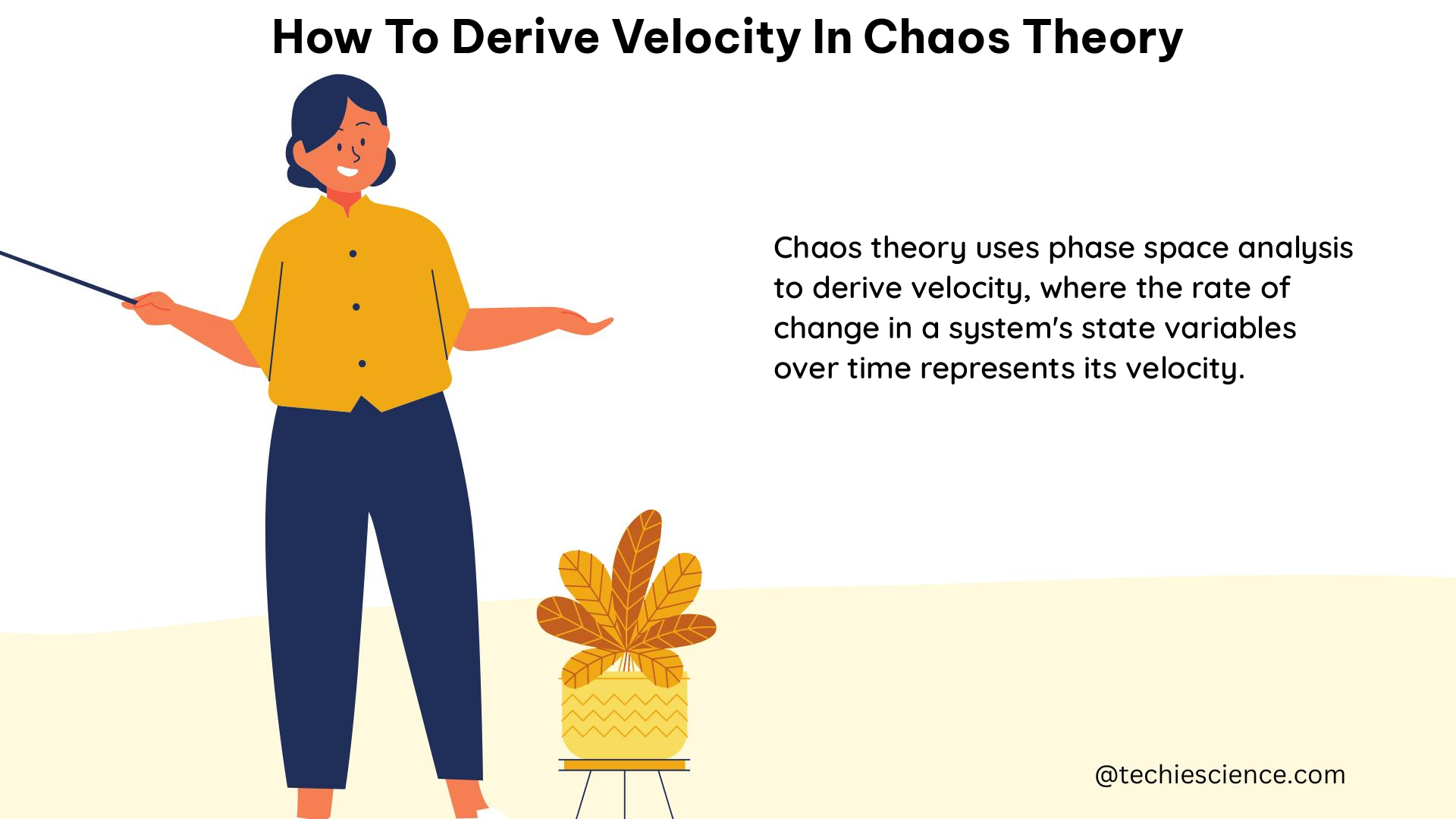Chaos theory is a field of study that examines the behavior of complex, nonlinear systems. Deriving velocity in chaos theory involves the use of various mathematical tools and techniques, including Lyapunov exponents, fractal dimensions, Kolmogorov-Sinai entropy, and correlation dimension. This comprehensive guide will provide you with the necessary knowledge and practical steps to derive velocity in chaos theory.
Lyapunov Exponents
Definition
Lyapunov exponents are a measure of the rate of divergence or convergence of two initially close trajectories in a dynamical system. They are used to quantify the degree of chaos in a system. The Lyapunov exponent is defined as:
$$\lambda = \lim_{t \to \infty} \frac{1}{t} \ln \frac{d(t)}{d(0)}$$
where $\lambda$ is the Lyapunov exponent, $d(t)$ is the distance between the two trajectories at time $t$, and $d(0)$ is the initial distance.
Calculation
To calculate the Lyapunov exponent, you need to compute the Jacobian matrix of the system and then find the eigenvalues of the Jacobian. The Lyapunov exponent is the maximum eigenvalue. The Jacobian matrix is defined as:
$$J = \begin{bmatrix}
\frac{\partial f_1}{\partial x_1} & \frac{\partial f_1}{\partial x_2} & \cdots & \frac{\partial f_1}{\partial x_n} \
\frac{\partial f_2}{\partial x_1} & \frac{\partial f_2}{\partial x_2} & \cdots & \frac{\partial f_2}{\partial x_n} \
\vdots & \vdots & \ddots & \vdots \
\frac{\partial f_n}{\partial x_1} & \frac{\partial f_n}{\partial x_2} & \cdots & \frac{\partial f_n}{\partial x_n}
\end{bmatrix}$$
$$\lambda = \max { \text{eigenvalues of } J }$$
Fractal Dimensions

Definition
Fractal dimensions are used to describe the complexity of attractors in chaotic systems. They are a measure of the self-similarity of the attractor.
Calculation
There are several methods to calculate fractal dimensions, including the box-counting dimension and the correlation dimension. The box-counting dimension is defined as:
$$D = \lim_{\epsilon \to 0} \frac{\ln N(\epsilon)}{\ln \frac{1}{\epsilon}}$$
where $D$ is the fractal dimension, $N(\epsilon)$ is the number of boxes of size $\epsilon$ needed to cover the attractor, and $\epsilon$ is the box size.
Kolmogorov-Sinai Entropy
Definition
Kolmogorov-Sinai entropy is a measure of the complexity of a dynamical system. It is used to quantify the rate of information loss in a chaotic system.
Calculation
The Kolmogorov-Sinai entropy is calculated using the following formula:
$$h = \lim_{\epsilon \to 0} \lim_{T \to \infty} \frac{1}{T} \ln \frac{1}{\epsilon} \sum_{i=1}^{N(\epsilon)} p_i \ln p_i$$
where $h$ is the Kolmogorov-Sinai entropy, $p_i$ is the probability of the $i$th box, $N(\epsilon)$ is the number of boxes of size $\epsilon$, and $T$ is the time.
Correlation Dimension
Definition
The correlation dimension is a measure of the complexity of a chaotic attractor. It is used to quantify the self-similarity of the attractor.
Calculation
The correlation dimension is calculated using the following formula:
$$D = \lim_{r \to 0} \frac{\ln C(r)}{\ln r}$$
where $D$ is the correlation dimension, $C(r)$ is the correlation function, and $r$ is the distance.
Example: Lorenz Attractor
The Lorenz attractor is a classic example of a chaotic system. It is defined by the following equations:
$$dx = 10(y-x)$$
$$dy = x(28-z)-y$$
$$dz = xy-8z/3$$
The Lyapunov exponents for the Lorenz attractor are approximately $\lambda_1 = 0.9056$, $\lambda_2 = 0$, and $\lambda_3 = -14.572$. The fractal dimension of the Lorenz attractor is approximately $D = 2.06$. The Kolmogorov-Sinai entropy is approximately $h = 0.815$.
Numerical Example
To illustrate the concepts, let’s consider a simple chaotic system, the logistic map, defined by the equation:
$$x_{n+1} = r x_n (1 – x_n)$$
where $x_n$ is the state of the system at time $n$ and $r$ is a parameter that controls the behavior of the system.
For $r = 4$, the system exhibits chaotic behavior. We can calculate the Lyapunov exponent, fractal dimension, and Kolmogorov-Sinai entropy for this system.
- Lyapunov Exponent:
- The Jacobian of the logistic map is $J = r(1 – 2x_n)$.
- The Lyapunov exponent is $\lambda = \lim_{n \to \infty} \frac{1}{n} \sum_{i=0}^{n-1} \ln |r(1 – 2x_i)|$.
-
For $r = 4$, the Lyapunov exponent is approximately $\lambda \approx 0.6931$.
-
Fractal Dimension:
-
The box-counting dimension of the logistic map attractor is approximately $D \approx 0.5362$.
-
Kolmogorov-Sinai Entropy:
- The Kolmogorov-Sinai entropy of the logistic map is approximately $h \approx 0.6931$.
These values provide a quantitative description of the chaotic behavior of the logistic map and can be used to derive the velocity of the system.
Conclusion
Deriving velocity in chaos theory involves the use of various mathematical tools and techniques, including Lyapunov exponents, fractal dimensions, Kolmogorov-Sinai entropy, and correlation dimension. By understanding and applying these concepts, you can gain valuable insights into the behavior of complex, nonlinear systems and derive the velocity of the system.
References
- Quantifying Chaos by Oxford Academic: https://academic.oup.com/book/30004/chapter-abstract/249821235?redirectedFrom=fulltext
- Chaos Analysis Framework: https://www.sciencedirect.com/science/article/pii/S1007570416301462
- Propagation of Chaos: https://www.sciencedirect.com/science/article/pii/S0304414917300688

The lambdageeks.com Core SME Team is a group of experienced subject matter experts from diverse scientific and technical fields including Physics, Chemistry, Technology,Electronics & Electrical Engineering, Automotive, Mechanical Engineering. Our team collaborates to create high-quality, well-researched articles on a wide range of science and technology topics for the lambdageeks.com website.
All Our Senior SME are having more than 7 Years of experience in the respective fields . They are either Working Industry Professionals or assocaited With different Universities. Refer Our Authors Page to get to know About our Core SMEs.